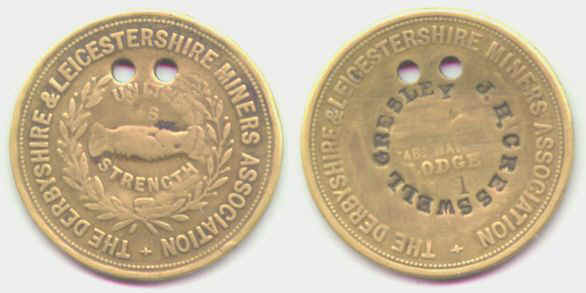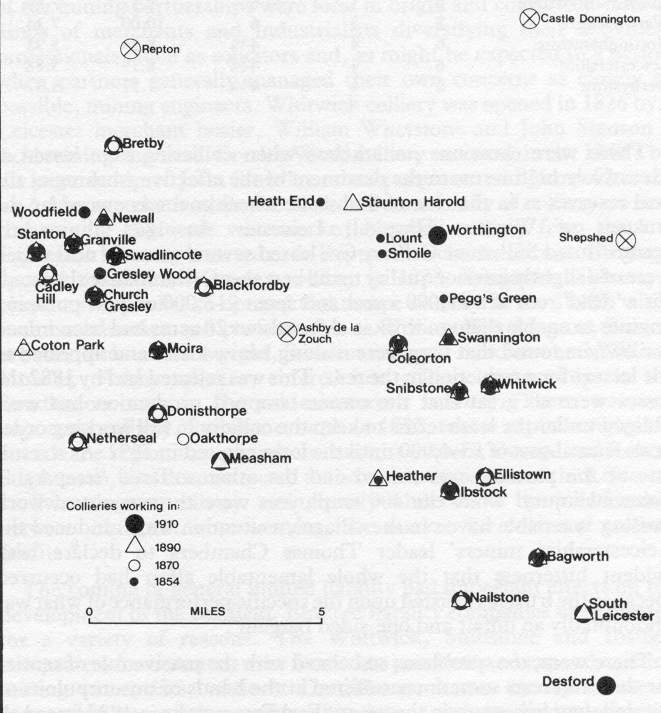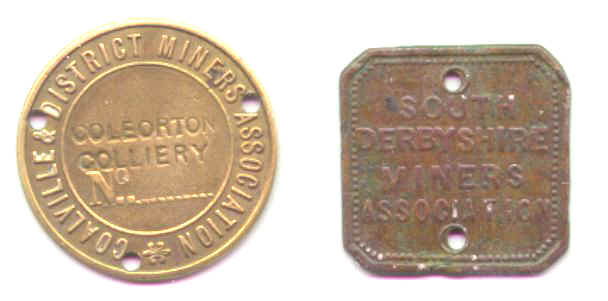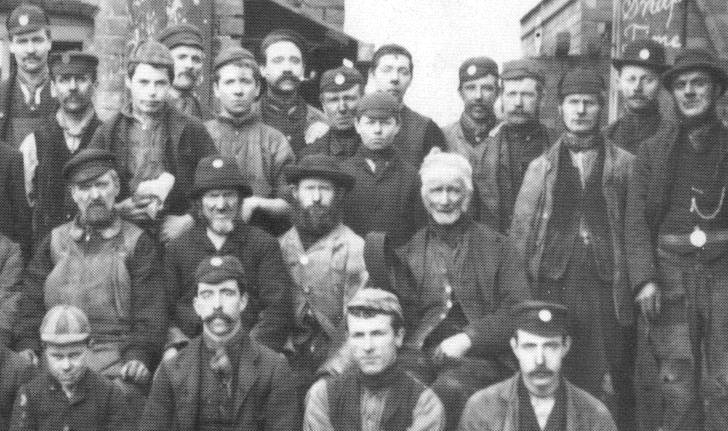
In Search of Mr. Cresswell and the Derbyshire & Leicestershire Miners' Association.
Most collectors of mining tokens will have at least one example in their collections of a check where instead of the usual identification numbers is stamped the name, initials or job title of the person to whom the check had originally belonged. A typical selection of such specimens is illustrated below.

Th
ree N.C.B. lamp/cage riding checks from Yorkshire with counter stamped legends. From left to right - "MR C ROUND" on a Royston Drift Mine check; "HIS NIBS" on the reverse side of a Thurcroft Main check & MR CHRISTMAS on a Hatfield colliery check.Many collectors highly prize such checks as they allow the rare opportunity to add a personal and historic link to be attributed to what would otherwise be a very impersonal piece of stamped metal. One of the best examples of such an attribution is described in an article written by Frank Burgin in the very first NMMA newsletter (May 1996). In this article Frank described how he had come across four brass embossed checks from Elsecar Low Pit. Each check carried in its reverse legend the date "1881" while on the obverse were stamped various pairs of initials instead of the usual lamp identification numbers. After much research Frank was able to match two out of the four pairs of initials on his checks with the names of colliers listed in a manpower ledger for Elsecar Low Pit dated 1881. Not only did this ledger list the names of the those employed at the pit but in many cases also gave their age and job title.
Ever since reading Frankís article I have wondered if it would possible to similarly identify any of the individuals whose names appeared on the checks in my collection. Unfortunately as yet this has not been possible. However, with the assistance of several other NMMA members plus a genealogist, from of all places New Zealand, I have been able to assist one fellow collector in a similar quest.
Some time ago I was shown a large minersí association check (i.e. an early type of union membership badge) by a collector from South Derbyshire. The check was of a type I had never seen before. It had been issued in the name of a very obscure early minersí union, The Derbyshire & Leicestershire Minersí Association (D&LMA). A photograph of this association check is illustrated below together with a full description.

Obverse and reverse of the enigmatic D&LMA check/badge (Actual size 38.5 mm).
Due to the poor condition of the reverse of the D&LMA check the following description has been put together with the assistance of photographs of almost identical checks supplied by John Whysall, Chris Matchett and Ian Coley.
Type: Minersí association badge/check. Round, brass embossed, 38.5 mm in diameter with two small sewing attachment holes located on the outer section of the check at the 12 oíclock position. Plain edge.
Obverse: Two shaking hands within a wreath surrounded by the legend THE DERBYSHIRE & LEICESTERSHIRE MINERS ASSOCIATION B all within a beaded border. Above and below the shaking hands a legend in three lines reads UNITY / IS / STRENGTH
Reverse: A heart resting on the palm of a hand surrounded by the legend THE DERBYSHIRE & LEICESTERSHIRE MINERS ASSOCIATION B all within a beaded border. Below the open hand a legend in three lines reads ESTAB. MAY 1873 / LODGE / No. plus the counter stamped number "1". Much of the reverse design has been obliterated owing to the check being partially filed smooth. Presumably its original owner had done this in order to apply the secondary counter stamped legend which reads "J.H. CRESSWELL GRESLEY".
The photographs of the similar check examples supplied by John Whysall and Chris Matchett were counter stamped with the respective lodge numbers "3" and "6". It is interesting to note the subject matter choice of a heart on an open hand depicted on the checkís reverse. An almost identical design to this exists on certain Nottinghamshire Minersí Association checks. We can no longer be sure what significance this symbolism had but presumably it was well known to those to whom such checks were originally issued in the 1880s and 1890s.
The wear and metal toning on that part of the check that has been filed smooth to apply the stamped legend appears to be identical to that on the rest of the check. Hence, it could be assumed that the counter stamped graffiti had been applied early on in the checkís life and not as a much later addition.
The counter stamped legend on the checkís reverse begged obvious questions such as who was J.H. Cresswell and where and when had he lived? Attempting to answer these questions would prove to be very interesting but by no means an easy task.
The check obviously could not pre-date the formation of the D&LMA and from the reverse legends of similar examples this was known to be May 1873. However, although this provided a commencement date to start the search for J.H. Cresswell it did not help in establishing a precise period in which to look for him. On stylistic grounds (i.e. its size, thickness plus the type and location of the attachment piercings) it was estimated that the check was most probably a relatively early type dating from the late 1870s to the 1890s. However, the D&LMA could potentially have been in existence well into the 1900s and as such the check could have been issued at any time over a much longer time period. The next stage of the search would be to try and establish the precise period over which the D&LMA existed.
After having scoured the three standard histories covering both the Derbyshire and Leicestershire Coalfields (see list of references below) it appeared that there were no historical references what so ever to the D&LMA. Given the area in which the check originated plus the reference to the place name Gresley in the graffiti stamped on its reverse this association would almost certainly have served the miners working in the South Derbyshire and Leicestershire Coalfield. As such this early union would have been unrelated to the North Derbyshire Coalfield which was jointly served by the South Yorkshire plus the Nottinghamshire & Derbyshire Minersí Associations until 1880 and there after by the Derbyshire Minersí Association until 1945.

Collieries operating in the South Derbyshire & Leicestershire Coalfield between 1854-1910.
During the early 1840s minersí unions were set up in both the Leicestershire and South Derbyshire districts of the East Midlands Coalfield. Both of these early unions suffered due to their relatively small size, restricted finances plus an inability to unite the workforce in each of their respective districts. Eventually these early unions collapsed. Union activity in the coalfield then remained dormant until the 1860s due essentially to a period of relatively good wage levels plus high market demands for coal.
In 1864 the Leicestershire miners were encouraged by the National Minersí Union of Great Britain to form their own local union branch. This new union initially met with success calling strike action which lead to the coal owners giving in to the miners' increased pay demands.
In the South Derbyshire district of the coalfield the interest in unionism was also renewed in 1867 by miners from the collieries at Church Gresley, Swadlincote and Netherseal. Unlike the miners working at some of the neighbouring pits of the Moira Coal Company the men at these collieries were severely disgruntled and believed that they would benefit greatly by forming a union. Their main grievances were that they were subject to the lowest rates of pay and longest working hours in the coalfield. They also protested to the continued implementation of the truck system plus the introduction of the "Billy Fairplay" system whereby they were not paid for any undersized material contained within the coal raised to bank.
With the assistance of the Derbyshire & Nottinghamshire Minersí Association and against all the efforts of the South Derbyshire Coal Owners Association a new union was established in South Derbyshire which by September 1867 had a membership of 900 men. This new union wasted no time in taking the coal owners to task by calling a strike of its membership. The coal owners retaliated by locking out the local miners and bringing in black legs from neighbouring coalfields. This enraged the local miners only further and soon the situation became violent with many special constables having to be drafted in from as far away as Birmingham to maintain the peace. With the drying up of the new unionís funds and membership, which had dwindled to only 400 by February 1868, it was soon brought to its knees. By March 1868 the union had caved in leaving the South Derbyshire mining community angry, divided and without industrial representation.
The miners union in the Leicestershire district of the coalfield operated throughout the 1860s with relative success compared to its short lived South Derbyshire neighbour. However, during the market boom period of the early 1870ís the union was slow to take advantage of the situation like other minersí unions in the Midlands which had already won pay increases on the back of a 40% increase in the selling price of coal. When in April 1873 the Leicestershire union eventually demanded the local coal owners to increase wage levels they were rejected and a strike followed. Despite the unionís good bargaining position and healthy membership of 2,000 colliers the strike collapsed through disunity amongst its membership. The Leicestershire union subsequently retrenched to reassess its future.
With the defeat and eventual collapse of both the South Derbyshire and Leicestershire minerís unions in 1868 and 1873 respectively there was a natural gap to be filled in respect to the effective representation of both groups of miners within the coalfield. It is in light of these historical events that I believe led to the formation of the D&LMA. By its very title it is obvious that this newly established union of May 1873 was intent, although not necessarily effective, in uniting the miners in both halves of the Coalfield under a single banner and common cause. Without firm historical data it is impossible to speculate on the successfulness or ultimate fate of the D&LMA. However, what is clear is that this union was not sufficiently successful to be remembered for any significant historical achievements like the ones immediately preceding it or that were to emerge shortly after its had been established. All indications point to the D&LMA being a very short lived organisation which didnít significantly influence the future development of mining unions within the coalfield.
What history does record is that shortly after the ill-fated strike of 1873 the Leicestershire miners union, bewildered by its defeat by the coal owners, approached both the Derbyshire & Nottinghamshire plus the Warwickshire Minersí Associations for assistance. Both unions offered the Leicestershire men affiliated membership which ultimately led to an alliance with the North Warwickshire Coalfield and the formation of the Leicester & Warwickshire Amalgamated Union of Miners (L&WAUM). Although this union picked up nearly 50% support from the Leicester miners by late 1873 it was to collapse two years later due to the dominance the Warwickshire miners had in its overall organisation. The break up of the L&WAUM led to the establishment of a smaller union in 1876 which initially was known by the title of the Leicestershire Minersí Association (L.M.A.) but which reformed itself in 1887 as the Coalville & District Minersí Association (C&DMA). This union plus a second formed in the western district of the coalfield that same year, the South Derbyshire Amalgamated Minersí Association (S.D.A.M.A), were ultimately to become the respective forerunners of the Leicestershire and South Derbyshire branches of the National Union of Mineworkers (N.U.M.) in 1945. Given the success of the C&DMA plus the S.D.A.M.A it is difficult to envisage that the relatively obscure D&LMA could have competed or survived much after their establishment in 1887.

Late C19th/early C20th Miners' Association Checks/Badges of both the Coalville And District (Coleorton Colliery Branch) plus the South Derbyshire Miners' Associations (Actual sizes 32 mm and 27.5 mm respectively).
Having unsuccessfully been able to find any records regarding the history of the D&LMA attention was next turned back to the enigmatic "J.H. Cresswell" referred to on the association checkís reverse. Having concluded that Cresswell was most likely to have been a collier living and/or working in the Church or Castle Gresley area of South Derbyshire during the period 1873 to 1887 the search for him could now move on a step further.
Enough background history had now been gathered about Cresswell to post a realistic request for further information concerning him on one or more of the Internetís genealogy discussion lists. Such lists operate on a group membership basis whereby genealogists and family history researchers from all over the world with a common interest in a particular UK county, surname or even a profession can post a question to an electronic mailing list. These messages are then received by all of the other list members (potentially thousands of people) who can reply if they have any relevant information. A request for information concerning Cresswell, based on what little was known or surmised about him, was thus posted onto the Internet. It was issued simultaneously to four separate genealogy lists. The first list was for those with interests related to Derbyshire, the second was one similar for Leicestershire, the next was dedicated to those interested in the surname "Cresswell" and finally the last for those specifically researching their ancestors in the coal mining industry.
A week went by and although several e-mail replies had been received from the various lists none of them were offering any positive leads in the search for Cresswell. It was then, just prior to giving up and de-subscribing to the various e-mail lists, that an unbelievable reply was received from Brett Payne off the Derbyshire list. Surprisingly Brett lives in New Zealand but has a specialised interest in South Derbyshire genealogy, so much so that he runs a web site devoted to the subject. It even turned out that Brett himself had Cresswells from South Derbyshire in his own family tree. This was his reply;
J.H. CRESSWELL appears to have been born c.1856 in Church Gresley, the son of Jedediah & Sarah CRESSWELL. He was baptised as Henry CRESSWELL on 4 February 1857 at Church Gresley, although his census records (1881 & 1891) always show him as John H(enry). His father Jedediah was born c.1820 in Denby (Derbyshire), while his mother Sarah (maiden name unknown) was born c.1822 in Dordon (Warwickshire).
John Henry had at least two sisters and a brother;
On 24 December 1881, John Henry (Coal miner of Church Gresley) married Ann HAMMOND (who stated here aged as 30, although she was actually 36!). Ann was the widow of James HAMMOND of Church Gresley, and daughter of Michael BRIELEY (Engine Driver) and Sarah LUNN of Church Gresley. Ann was illegitimate, but adopted the surname BREALEY (or BRIELEY). She had at least five children from her first marriage, and two of these are shown living with her and John Henry in the 1891 Census. There doesn't appear to have been any issue from her marriage to John Henry.
John Henry CRESSWELL is recorded as "Coal Miner" in both the 1881 and 1891Census. His father Jedediah, on the other hand, is recorded as having a variety of occupations; February 1857 as a Collier, December 1872 as a Collier, August 1880 as a Shopkeeper, April 1881 as a Hawker, December 1881 as a Potter and finally in April 1891 again as a Hawker.
So finally all had become clear. John Henry Cresswell had been a collier, like his father before him, from Church Gresley in South Derbyshire. Although we canít be sure at which pit John had been employed during his working life no doubt it was at one or more of the neighbouring collieries to Gresley. These included Church Gresley, Cadley Hill, Swadlincote, Granville, Newhall, Stanton, Blackfordby, Coton Park, Bretby No.3, Netherseal and the Moira Collieries. We also know that at sometime during his working life, presumably between 1873 and 1887, he had been a member of the No.1 Lodge of the D&LMA. It appears that this had been a short lived minersí union comprising a minimum of six separate lodges located across the South Derbyshire and Leicestershire Coalfield.
Minersí Association Checks - A Footnote.
Minersí association checks were strictly speaking an early form of union membership badge. They were commonly worn by colliers during the period 1880-1920 although it is known that their use continued in some regions right up until the formation of the National Union of Mineworkers in 1945.

A group of North Derbyshire miners from Pilsley Colliery Photographed in 1895. Their Miners' Association Checks/Badges are clearly visible attached to their caps.
Examples of minersí association checks can be found in a multitude of different metals, shapes and sizes but are nearly always characterised by the appearance of two (or more) small pierced holes at the 3 and 9 oíclock positions around their outer circumference. These holes were used to sew the checks onto to their ownersí jacket lapels or caps so as to be readily discernible to others. The public displaying of such checks was primarily done to indicate that their wearers were loyal and paid up members of a certain union branch or lodge. The fact that each minersí association branch/lodge would frequently change the shape or design of their checks to coincide with each financial subscription period was a good means of ensuring that their membership kept up to date in paying their union dues. For example the failure of a collier to wear and display the latest design of his branch/lodgeís association check would indicate to others that he hadnít been issued with the latest design of check and hence was not a paid up member of his respective minersí association.
Acknowledgements:
I would like to thank the following people for their assistance in the search for information concerning J.H. Cresswell and the D&LMA; Brett Payne, Chris Matchett, John Whysall, Ian Coley and last but not least Mike Shaw.
References:
The Leicestershire And South Derbyshire Miners. Volume I (1840-1914) by Colin Griffin. Published by the N.U.M. Leicestershire Area. Coalville. 1981
The Leicestershire And South Derbyshire Coalfield (1200-1900) by Colin Owen. Moorland Publishing. 1984.
The Derbyshire Miners - A Study In Industrial And Social History by J.E. Williams. George Allen And Unwin. 1962.
Brett Payne's
"South Derbyshire Genealogical Resources Web Site" located on the
"Net" at http://freepages.genealogy.rootsweb.com/~brett/sdindex.htm
Based on a forthcoming article in NMMA Newsletter No.25, 2001. © Mark Smith